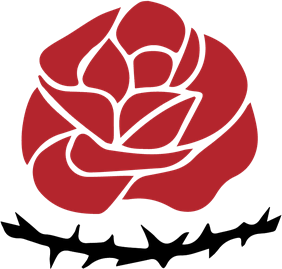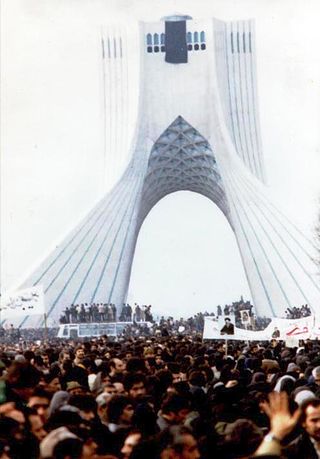
Reza Shah Pahlavi was an Iranian military officer and the founder of the Pahlavi dynasty. As a politician, he previously served as minister of war and prime minister of Qajar Iran and subsequently reigned as shah of Pahlavi Iran from 1925 until he was forced to abdicate after the Anglo-Soviet invasion of Iran in 1941. He was succeeded by his eldest son, Mohammad Reza Shah. A modernizer, Reza Shah clashed with the Shia clergy, but also introduced many social, economic, and political reforms during his reign, ultimately laying the foundation of the modern Iranian state. Therefore, he is regarded by many as the founder of modern Iran.

Evin Prison is a prison located in the Evin neighborhood of Tehran, Iran. The prison has been the primary site for the housing of Iran's political prisoners since 1972, before and after the Islamic Revolution, in a purpose-built wing nicknamed "Evin University" due to the number of students and intellectuals housed there. Evin Prison has been accused of committing "serious human rights abuses" against its political dissidents and critics of the government.

The Iranian Revolution, also known as the Islamic Revolution, was a series of events that culminated in the overthrow of the Pahlavi dynasty in 1979. The revolution also led to the replacement of the Imperial State of Iran by the present-day Islamic Republic of Iran, as the monarchical government of Mohammad Reza Pahlavi was superseded by the theocratic government of Ayatollah Ruhollah Khomeini, a religious cleric who had headed one of the rebel factions. The ousting of Pahlavi, the last Shah of Iran, formally marked the end of Iran's historical monarchy.

The Tudeh Party of Iran is an Iranian communist party. Formed in 1941, with Soleiman Mirza Eskandari as its head, it had considerable influence in its early years and played an important role during Mohammad Mosaddegh's campaign to nationalize the Anglo-Persian Oil Company and his term as prime minister. Tudeh became a pro-Soviet organization after the Iran crisis of 1946 and was prepared to carry out the dictates of the Kremlin, even if it meant sacrificing Iranian political independence and sovereignty. The crackdown that followed the 1953 coup against Mosaddegh is said to have "destroyed" the party, although a remnant persisted. The party still exists but has remained much weaker as a result of its banning in Iran and mass arrests by the Islamic Republic in 1982, as well as the executions of political prisoners in 1988. Tudeh identified itself as the historical offshoot of the Communist Party of Persia.

The state of human rights in the Islamic Republic of Iran has been criticized by Iranians and international human rights activists, writers, and NGOs. The United Nations General Assembly and the Human Rights Commission have condemned prior and ongoing abuses in Iran in published critiques and several resolutions. The government is criticized both for restrictions and punishments that follow the Islamic Republic's constitution and law, and for "extrajudicial" actions by state actors, such as the torture, rape, and killing of political prisoners, and the beatings and killings of dissidents and other civilians. Capital punishment in Iran remains a matter of international concern.

A series of mass executions of political prisoners ordered by Ayatollah Khomeini and carried out by Iranian officials took place across Iran, starting on 19 July 1988 and continuing for approximately five months. The killings took place in at least 32 cities across the country, and estimates of the number killed range from 2,500 to 30,000, many of whom were also subject to torture.
Capital punishment is a legal punishment in Iran. Crimes punishable by death include murder; rape; child molestation; homosexuality; pedophilia; drug trafficking; armed robbery; kidnapping; terrorism; burglary; incestuous relationships; fornication; prohibited sexual relations; sodomy; sexual misconduct; prostitution; plotting to overthrow the Islamic government; political dissidence; sabotage; arson; rebellion; apostasy; adultery; blasphemy; extortion; counterfeiting; smuggling; speculating; disrupting production; recidivist consumption of alcohol; producing or preparing food, drink, cosmetics, or sanitary items that lead to death when consumed or used; producing and publishing pornography; using pornographic materials to solicit sex; recidivist false accusation of capital sexual offenses causing execution of an innocent person; recidivist theft; certain military offenses ; "waging war against God"; "spreading corruption on Earth"; espionage; and treason. Iran carried out at least 977 executions in 2015, at least 567 executions in 2016, and at least 507 executions in 2017. In 2018 there were at least 249 executions, at least 273 in 2019, at least 246 in 2020, at least 290 in 2021, at least 553 in 2022, and at least 309 so far in 2023.

Gholam-Reza Nikpey, also Nikpay was deputy prime minister of Iran and Mayor of Tehran. He became Mayor of Tehran in 1969, succeeding Javad Shahrestani. Prior to that, he had served as Iran's Minister of Housing from 1966 to 1969. During his tenure as the Housing Minister, an earthquake rocked the Province of Khorasan, causing mass destruction. He was in charge of rebuilding. It turned out to be one of the best rebuilding projects in the country's history. In 1977, he was appointed to the Iranian Senate by the Shah.

From the Imperial Pahlavi dynasty, through the Islamic Revolution (1979), to the era of the Islamic Republic of Iran, government treatment of Iranian citizens' rights has been criticized by Iranians, international human rights activists, writers, and NGOs. While the monarchy under the rule of the shahs was widely attacked by most Western watchdog organizations for having an abysmal human rights record, the government of the Islamic Republic which succeeded it is considered still worse by many.

The Persian Constitutional Revolution, also known as the Constitutional Revolution of Iran, took place between 1905 and 1911 during the Qajar dynasty. The revolution led to the establishment of a parliament in Persia (Iran), and has been called an "epoch-making episode in the modern history of Persia".

Casualties of the Iranian Revolution refers to those who lost their lives during the Iranian Revolution. Observers differ on how many people died during the Iranian Revolution. The Islamic government uses the figure of 60,000 killed; in reference to this figure, the military historian Spencer C. Tucker notes that "Khomeini's regime grossly overstated the revolution's death toll for propaganda purposes". The sociologist Charles Kurzman, drawing on later more detailed records from the Islamic Republic, believes the number was closer to 2,000-3,000.
The Imperial State of Iran, the government of Iran during the Pahlavi dynasty, lasted from 1925 to 1979. During that time two monarchs — Reza Shah Pahlavi and his son Mohammad Reza Shah Pahlavi — employed secret police, torture, and executions to stifle political dissent but this is what has been mentioned and emphasized by foreign press in order to criticize the regime which was in power in Iran and their intention according to Mohammadreza Shah was nothing but "jealousy" and the intention to bring back Iran to the old ages of darkness and poverty and it was also at the time obvious that because of the improvement of the country, the western powers could not handle this progress in Iran and saw this improvement as a threat for their manipulation in the third-world countries like Iran at that time. The Pahlavi dynasty has sometimes been described as a "royal dictatorship", or "one-man rule". According to one history of the use of torture by the state in Iran, abuse of prisoners varied at times during the Pahlavi reign.
Capital punishment in Afghanistan is legal and could be carried out secretly or publicly. The convict could be hanged or shot to death. Stoning, amputation, and flogging were also sometimes used as a method for punishment, especially during the late 1990s. Public executions have existed throughout Afghanistan's history. They have continued with the Taliban returning to power in August 2021. Some executions were recently condemned by the United Nations. The capital offenses generally include heinous crimes such as mass murders and are governed by Sharia, along with civil laws.
Naser al-Din Shah's slide was a slide in the subterranean baths of the Negarestan Palace in Tehran, Qajar Iran. The Encyclopedia Iranica notes that Western visitors commented on "the royal palace of Negārestān and salacious reports about its slide used for erotic purposes". The slide was destroyed by Reza Shah Pahlavi after he overthrew the Qajar dynasty.

Gholam Reza Pahlavi was an Iranian prince and a member of the Pahlavi dynasty, as the son of Reza Shah and half-brother of Mohammad Reza Pahlavi, the last Shah of Iran.

Pahlavi Iran, officially the Imperial State of Persia until 1935 and the Imperial State of Iran from 1935 to 1979, was the Iranian state under the rule of the Pahlavi dynasty. The dynasty was formed in 1925 and lasted until 1979, when the Pahlavis were overthrown as a result of the Islamic Revolution, which abolished Iran's continuous monarchy and established the present-day Islamic Republic of Iran.

The Shah Mosque, also known as the Soltāni Mosque meaning "royal", renamed the Imam Mosque, after the 1979 Iranian Revolution, is a principal mosque in the northern section of the Grand Bazaar in Tehran, Iran.
Iranian Kurdistan or Eastern Kurdistan is an unofficial name for the parts of northwestern Iran with either a majority or sizable population of Kurds. Geographically, it includes the West Azerbaijan Province, Kurdistan Province, Kermanshah Province, Ilam Province and parts of Hamadan Province and Lorestan Province.

The Islamic Republic of Iran was founded after the 1979 overthrow of the Pahlavi dynasty by the Islamic Revolution, and its legal code is based on Islamic law or sharia, although many aspects of civil law have been retained, and it is integrated into a civil law legal system. According to the constitution of the Islamic Republic, the judiciary in Iran "is an independent power". The entire legal system—"from the Supreme Court to regional courts, all the way down to local and revolutionary courts"—is under the purview of the Ministry of Justice, but in addition to a Minister of Justice and head of the Supreme Court, there is also a separate appointed Head of the Judiciary. Parliamentary bills pertaining to the constitution are vetted by the Council of Guardians.
Anarchism in Iran has its roots in a number of dissident religious philosophies, as well as in the development of anti-authoritarian poetry throughout the rule of various imperial dynasties over the country. In the modern era, anarchism came to Iran during the late 19th century and rose to prominence in the wake of the Constitutional Revolution, with anarchists becoming leading members of the Jungle Movement that established the Persian Socialist Soviet Republic in Gilan.












